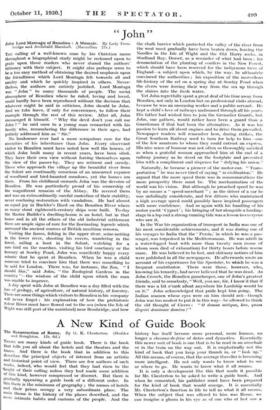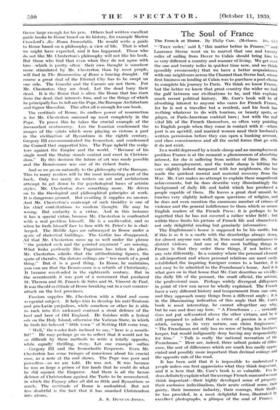A New Kind o f Guide Book
The Resurrection of Rome. By G. K. Chesterton. (Hodder and Stoughton. 12s. Od.) Tomo: are many kinds of guide book. There is the Wok that tells you all about the hotels and the theatres and the trams. And there is the book that in addition to this describes the principal objects of interest from an artistic and historical point of view. There are few authors of such works, indeed, who would feel that they had risen to the 'height of their calling unless they had made some addition of this kind, however compressed or discreet. But there is gradually appearing a guide book of a different order. In this there is the minimum of geography ; the names of hotels and their prices occupy a very subordinate place. The main theme is the history of the places described, and the more intimate habits and customs of the people. And the history has itself become more personal, more human, no longer a chreaux-de-frise of dates and dynasties. Essentially this newer sort of book is one that is to be read in an armchair or in the train on the way out. It is emphatically not the kind of book that you keep your thumb in, or "look up." All this means, of course, that the average tioveller is becoming more intelligent. Ile not only wants to know what to see or where to go. He wants to know what it all means. It is only a development like this that niade it possible for Mr. Chesterton to be asked to write a guide book. And when he consented, his publisher must have been prepared for the kind of book that would emerge. It is essentially Mr. Chesterton's function in life to tell us what it all means. When the subject that was offered to him was Rome, we can imagine a gleam in his eye as of one who at last saw a theme large enough for his pen. Others bad written excellent guide books to Rome based on its history, for example Marion Crawford's Ave Roma Immortalis. He would write a guide to Rome based on a philosophy; a view of life. That is what we might have expected, and it has happened. Those who do not like Mr. Chesterton's philosophy will not like his book. But those who find that even when they do not agree with him—which is pretty often—their own thought is somehow more stimulated by Mr. Chesterton than by most people, will find in The Resurrection of Rome a bracing draught. Of course a great deal of the Eternal City has to be swept on one side. The Gracchi and the Caesars are not there. For Mr. Chesterton they are dead. Let the dead bury their dead. It is the Rome that is alive, the Rome that has risen from the dead, that interests him, and so the things of which be principally has to tell are the Pope, the Baroque Architecture and Signor Mussolini. This after all is enough for one book.
The certitude of Rome, its endless power of resuisection is for Mr. Chesterton summed up most completely in the Pope. To prove this he takes the crucial example of the Inconoclast controversy. Leo the Isaurian condemned the images of the saints which were playing so riotous a part in the civilization of Byzantium in the eighth century. Gregory III excommunicated the Iconoclast, and condemned the Council that supported him. The Pope upheld the sculp- tors against the Empire and the world. " Because of his single word the Statue stands central and erect in Christen- dom." By this decision the future of art was made possible and the Renaissance was one of its richest fruits.
And so we go on naturally to the philosophy of the Baroque. This to many readers will be the most interesting part of the bock. Only too rarely do writers on art and architecture attempt to get down to the psychological bases of artistic styles. Mr. Chesterton does something more. He drives on to the theological and philosophical principles at work. It is dangerous ground. But avoiding it supplies no answer. And Mr. Chesterton's contempt of such timidity is one of his chief contributions to modern thought. He may be wrong. But audacity is a virtue. And in this instance it has a special virtue, because Mr. Chesterton is confronted with a real problem himself. He is a medievalist, and so when he finds himself face to face with St. Peter's he is chal- lenged. The Middle Ages are submerged in Rome under a srate of rhetorical buildings. The Gothic has disappeared. All that Mr. Chesterton SUMS up so well under the phrase "the pointed arch and the pointed argument" are missing. What looks perilously like Paganism has taken its place. Mr. Chesterton admits that the attitudinizing figures, the spate of cherubs, the riotous ceilings are "too much of a good thing." But sit is a good thing. In Rome, he maintains, you can see that the Renaissance is a rebirth of Christianity. It became overloaded in the eighteenth century. But in the seventeenth it was part of a movement that produced St. Theresa and St. Francis de Sales and St. Vincent de Paul. Rivas the old certitude of Rome breaking out in a vast counter- attack on the lost provinces.
Fascism supplies Mr. Chesterton with a third and snore coegenial subject. It helps him to develop his anti-Teutonic and pro-Latin prejudices, while somehow or other he is able to tuck into this awkward contrast a stout defence of the beef and beer of Old England. He finishes with a lyrical ode on the Holy Island, otherwise the Vatican State, in which he finds his beloved " little town" of Notting Hill come true, " Well," the reader feels inclined to say, "here is a mouth- ful!" He may perhaps go on to reflect that it would not be so difficult by these methods to write a totally opposite, while equally thrilling, story. Let one example suffice —Gregory HE and the Iconoclastic Emperors. Even Mr. Chesterton has some twinges of conscience about his crucial case, as a note at the end shows. The Pope was poor and powerless—so we are told. He was not. It was because he was so large a prince of fair lands that he could do what he did against the Emperor. And there is all the heroic defence of Christendom against the Turks to be remembered, in which the Papacy after all did so little and Byzantium so much. The certitude of Rome is undoubted. But not less doubtful is the fact that it has smashed Christendom into atoms.
A. S. Dustcsts-JoNss.









































 Previous page
Previous page